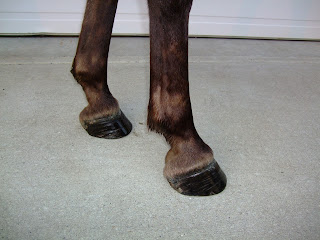Sunday, November 23rd. Now that her feet are trimmed, and Flicka is in process of gaining proper posture, I consider putting her out in the big pasture and integrating her with the herd. I am eager to do this because she was depressed and lonely as well as in need of light exercise and proper low sugar, fibre rich food. And it is movement that pumps the blood through the hoof, brings in the nutrition, takes out the toxins, starts to build the sole and in the end, will grow a healthy new foot. The one big challenge is that Flicka is not very fit, and while she is moving well despite her condition, she could seriously injure herself if she runs too fast, too much, too soon. While she walks like you would expect a laminitis case to walk; staggered, front hooves out front, in a wide waddle; she is walking, and even took off in the riding ring at a trot and canter, with a buck or two thrown in for good measure.
 |
| Sunday morning, I lead Flicka towards the herd. |
 |
| This pony hardly knows me, but we already trust each other. "Okay, I will follow you across the ice . . ." |
Now that her hooves are trimmed properly, her tendons and muscles need to readjust and strengthen for the right posture - and that takes time and it is painful. In the end, I choose to put her in with the herd. The benefits outweigh the risk. I also choose not to give her bute, those of you reading are probably wondering why I did not do that first thing. It is like any human, if your back is sore, and you take pain killer and go and shovel snow anyways, you run the risk of injuring yourself more seriously; and we have a brain that processes information in such a way that should help us make the right decision. Horses do not have that advantage. I was hoping Flicka would self regulate, and drugging her is not wise in that situation. I also assumed my horses would behave normally, kick and bite and chase a bit, then settle down to grazing.
One of the most satisfying things in the world, is putting a new horse in a 120 acre pasture, with a herd of horses, willows for natural wind breaks, a spring for water, hills for great exercise, covered
 |
| There they are . . . Flicka had already met them across the corral fence. |
with native prairie grassland. This forage in the fall and winter is the best forage in the world for horses. They eat cured nutritious grass with a high fibre content for much of the day, moving who knows how far, some estimates are 20 km per day, grazing, walking, grazing, running, grazing, standing in the sun, grazing and walking . . . and so on.
I brought Flicka out on Sunday morning so I could supervise and evaluate the herd joining process while having my coffee.
After a short while, I decided my one big gelding was going above and beyond normal chasing instincts, and I interfered, caught him and corralled him. A fit horse could take chasing and herding, but not a fat little pony, with little muscle tone with laminitis. On a positive note, Flicka did offer up some well timed kicks and squeals in protest. She probably could have taken care of herself, but I am not willing to risk her getting injured. By the next day, you could see Flicka with the herd, just a bit outside the circle, with the odd horse pointing out she was not fully accepted yet. It will take a while, but in the end, they will accept her, and some of the broodmares will most likely start to take care of her sooner than later. Patience. In the mean time, Flicka is getting good roughage, filling her belly with low sugar, natural horse food and moving on soft ground; with a proper hoof trim! All is well.
copyright Windy Coulee Canadian Horses - Heidi Eijgel












































